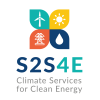What are the economic benefits for renewable energy companies of having more reliable S2S forecasts? S2S4E is working to find out.
As part of the research, the S2S4E project is working to evaluate what are the economic outcomes for companies testing the new forecasting tool for clean energy and energy demand, the S2S4E Decision Support Tool (DST).
To do this, the S2S4E team will – until the project ends in November 2020 – monitor how risk is managed when relying on the DST compared to using the information available up to now. The exercise will be applied to various decisional processes such as energy trading or operations and maintenance, explains Ilaria Vigo. She is an environmental economist at the Barcelona Supercomputing Center, the institution which is coordinating the project.
The assessment is vital to improving the climate service
“We’re doing this because we want to demonstrate the potential benefits of using this new climate service, the DST, and also because we wish to identify potential, necessary improvements to the service by highlighting where and when it fails to deliver valuable information to the decision-makers” Vigo says. “Being able to identify the pitfalls is the first step to overcome them” she adds.
The main focus of the analysis is to understand the impact of the Decision Support Tool to the decision-making processes of producers of renewable energy.
Dealing with extreme events: case studies from the past
As starting point of this work, the S2S4E team has conducted a study looking at decision-making under eight specific extreme weather events of the past. These eight case studies have been identified by stakeholders as key moments of the past due to anomalous weather conditions, Vigo explains.
Examples of cases studies are the strong icing event occurred in Romania in Jan-Feb of 2014, which caused power outages due to a shutdown of several wind farms, and the cold waves in France and Germany in 2017 and 2018, which contributed to fluctuations in energy prices.
Overall, this first study found that sub-seasonal forecasts delivered by DST could be useful to support financial decisions and operations and maintenance (O&M) decisions while seasonal forecasts serve budget planning under extreme weather events. It’s important to notice that the results from this first study cannot be generalized for all events, being that they are dependent on case-specific characteristics. However, this approach allows different audiences to grasp the fundamentals of the decision processes under analysis and proves that potential benefits exist from using S2S forecasts and helps to detect where there is room for improvement.
Background
The expansion of renewable energy is key to reducing Europe's greenhouse gas emissions, but the amount of power produced by clean energy sources depends on the weather, and forecasts of future renewable power production are often inaccurate.
S2S4E (Sub-Seasonal to Seasonal Climate Forecasting for Energy), a project funded by the EU's research and innovation programme Horizon 2020, is working to make forecasts for renewable power generation more reliable and usable.
To achieve this goal, S2S4E has developed a Decision Support Tool for the energy industry, which is free to use at least until the end of 2020.
The S2S4E Decision Support Tool shows predictions for solar, wind and hydropower generation for the coming weeks and months, with prognosis ranging from one week to three months ahead.
The DST also provides forecasts for energy demand and supply/demand balance, both of which are highly weather-dependent, especially in countries that rely on electricity for heating and cooling.
The S2S4E Decision Support Tool has been carefully co-designed with leading industrial stakeholders to assist in decision-making and become a game-changer for the electricity market.
Written by Ilaria Vigo / BSC and Iselin Rønningsbakk / CICERO.


